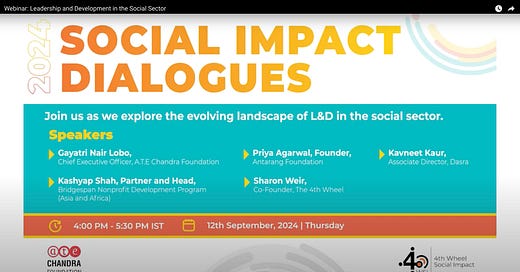We’ve all watched or listened to panel discussions at conferences or online. They can be engaging, they may bring up sharp insights, they sometimes also lead to hot debates – but rarely does a panel discussion cover so much ground in a structured manner that it can be considered a primer in that domain, or a single source that captures the state of a particular field.
I recently watched the recording of a panel discussion that did precisely this. Titled “Leadership and Development in the Social Sector”, it was moderated by Sharon Weir of 4th Wheel Social Impact, and featured Priya Agarwal (Antarang Foundation), Kashyap Shah (Bridgespan), Kavneet Kaur (Dasra), Gayatri Nair Lobo (A.T.E. Chandra Foundation).
The topic under discussion was learning and development (L&D) – or Capacity Building – of nonprofits. The hour-long conversation turned out to be a superb overview on the subject, covering the importance of L&D, current approaches to L&D (and gaps therein), constraints and challenges, L & D strategies relevant for all nonprofits, and calls to action to both nonprofits and donors.
Like any good primer, the webinar covered the basics many of us are familiar with. But what struck me were the more nuanced aspects one tends to miss from a high-level view of L&D for nonprofits.
Priya Agarwal highlighted narrative building as a significant gap in the L&D opportunities available in the social sector. While there are programs focused on areas like human resources, finance, fundraising, and communications, she felt there's a lack of focus on developing the ability to craft compelling narratives in public-facing content. Connecting diverse ideas and weaving them into a clear narrative is a skill that goes beyond basic communication or strategy building – it’s really the art of shaping a powerful story.
Priya also brought up the importance of budgeting as a strategic skill beyond basic accounting. She emphasized that budgeting should be seen as a process of translating an organization's strategic vision into a concrete financial plan, and highlighted the role of budgeting in connecting an organization's strategy with its funding needs. A budget should effectively convert strategic goals into a clear and compelling ask for donors.
Both Kashyap and Kavneet stressed that Capacity Building or L&D is not just “training”: effective capacity building can take various forms, including cohort-based programs, mentorship, coaching, and collaborative knowledge sharing. Further it is not just about money but also time: L&D requires a conscious commitment from leadership to carve out dedicated time for learning and reflection, both at the individual and organizational levels.
Gayathri challenged the practice of treating L&D as a separate, non-programmatic expense. She encouraged nonprofits to integrate L&D costs into their core budgets, arguing that it should be considered a fundamental investment in people, and therefore an essential expense. This reframing of L&D costs can help nonprofits make a stronger case for funding support from donors. And the more we speak this language and do it consistently, the more this will become the norm rather than the exception.
Gayathri also highlighted the need to gather data and insights to demonstrate the impact of L&D and advocate for increased investment into capacity building. She encouraged nonprofits to participate in research initiatives and share their experiences: their contribution here was key to building a stronger evidence base for capacity building.
One point echoed by everyone was the need to expand capacity building opportunities beyond the founders and leaders to encompass all levels of an organization. Priya pointed out a concerning trend of "over-capacitating" top leadership while neglecting the development needs of those in the next tier. Kashyap added that developing second-line leaders is often more appealing to CEOs and founders because they recognize the need for a strong second-in-command to support their own work. Gayathri shared her experience of learning from partners like Priya, who identified the lack of L&D opportunities for second-line leaders as a critical gap: this feedback prompted ATE Chandra Foundation to prioritize funding for programs targeting this group and smaller organisations who cannot join L&D programmes. Kavneet stressed the importance of recognizing the crucial role of middle management and first-time managers in this context.
This last point also resonated a lot with us at India Partner Network. Our aim is to make Capacity Building accessible to all. One form of this approach is to amplify the reach of excellent webinars related to capacity building . Watch this one: it will be worth your time.
- Manohar Sreekanth (Partner & CTO, Sattva Consulting)





